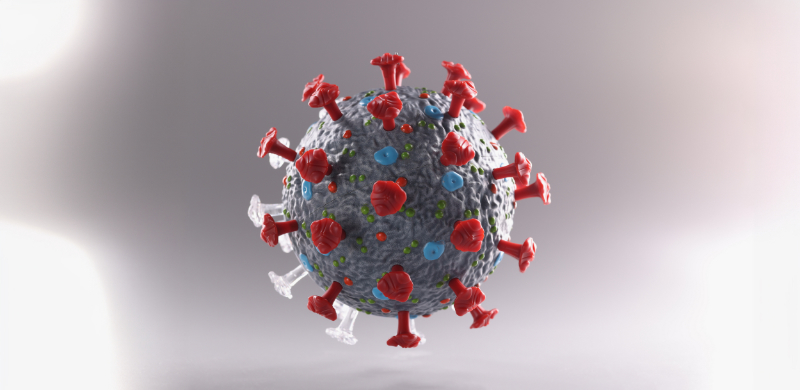For children, COVID-19 is typically a mild illness, often much milder than when adults are infected. Typical symptoms include (Lee & Hsueh, 2023; Sick-Samuels, 2021):
- Sore throat
- Fever
- Nasal congestion or rhinorrhea
- Fatigue
- Nausea
- Vomiting
- Diarrhea
- Myalgia
These signs and symptoms generally last between 7-14 days (Lee & Hsueh, 2023; Sick-Samuels, 2021).
Severe illness requiring intensive care, and deaths from COVID-19 are rare in children. However, for poorly understood reasons, sometimes a widespread, dysregulated inflammatory response occurs during or shortly after SARS-CoV-2 infection in children. This is what is known as MIS-C.
Affected children may have experienced COVID-19 symptoms or may have been asymptomatic and unaware they even had the virus. The disease may occur within the first week or two of viral infection or may be delayed as much as six weeks after (Lee & Hsueh, 2023; Sick-Samuels, 2021).
The hallmark symptoms of MIS-C include (Lee & Hsueh, 2023; Sick-Samuels, 2021):
- Persistent fever
- Systemic inflammation
- Organ dysfunction
Children affected by MIS-C almost unanimously present with a persistent fever lasting more than 3-4 days, fatigue, and malaise that do not respond well to pain relievers and antipyretics. Gastrointestinal symptoms like nausea, vomiting, diarrhea, and abdominal pain are common and often severe or worsening (Lee & Hsueh, 2023; Sick-Samuels, 2021). In fact, these are the symptoms that may be what initially brings children to the emergency room for evaluation (Lee & Hsueh, 2023; Sick-Samuels, 2021).
Vascular swelling causes conjunctival injection, erythema, and edema of the mouth and tongue, lymphadenopathy, edema of the hands and feet, and sometimes a generalized macular or even purpuric rash (Lee & Hsueh, 2023; Sick-Samuels, 2021). Children may have neck pain, chest pain, and altered mental status. These children appear ill, and the constellation of symptoms are not likely to be ignored or minimized by parents or clinicians (Lee & Hsueh, 2023; Sick-Samuels, 2021).
One of the most dangerous features of this condition is involvement of the heart. Nearly all parts of the heart may be affected, with coronary artery dilation and aneurysm, pericarditis, myocarditis, valvulitis, and abnormal electrical conductivity all being common (Lee & Hsueh, 2023; Sick-Samuels, 2021). Dysfunction of the left ventricle and reduced ejection fraction can lead to acute heart failure and cardiogenic shock (Lee & Hsueh, 2023; Sick-Samuels, 2021).
A cascade of inflammatory markers consistent with a cytokine storm and hyperinflammation are commonly present, with elevation of interleukin-6 (IL-6), erythrocyte sedimentation rate (ESR), C-reactive protein (CRP), procalcitonin, and ferritin (Lee & Hsueh, 2023; Sick-Samuels, 2021). Low platelet counts may also occur and then a rebound effect of coagulopathy from increased d-dimer and fibrinogen may lead to erratic blood clotting and stroke (Lee & Hsueh, 2023; Sick-Samuels, 2021). Elevated WBCs and neutrophils with a shift to the left are common as well as hypoalbuminemia and hyponatremia. Acute kidney and liver injury may occur, and fluid accumulation leads to widespread edema, pericardial effusion, pleural effusion, and ascites. Hemodynamic instability, shock, and heart failure are among the most serious symptoms that may need aggressive support (Lee & Hsueh, 2023; Sick-Samuels, 2021).
Please use the following table to organize achild’s signs and symptoms of MIS-C by body system.
Table 1. Disease Process by Body System| Body System | Signs and Symptoms |
|---|
| General | Persistent fever, fatigue, malaise, muscle aches |
HEENT
(Head, Eyes, Ears, Nose, Throat) | Conjunctival injection, erythema and edema to lips/tongue/mouth, neck pain, cervical lymphadenopathy |
| Cardiac | Chest pain, coronary artery dilation, coronary artery aneurysm, valvulitis, pericarditis, pericardial effusion, myocarditis, abnormal electrocardiogram (ECG), left ventricular dysfunction, acute heart failure, cardiogenic shock |
| Gastrointestinal | Nausea, vomiting, diarrhea, intense or worsening abdominal pain |
| Renal | Acute kidney injury |
| Hepatic | Acute liver injury |
| Pulmonary | Pleural effusion |
| Skin | Generalized macular or purpuric rash |
| Hemodynamic | Swelling of hands and feet, ascites, unstable blood pressure, shock, elevated inflammatory markers (ESR, CRP), hypercoagulability, hypoalbuminemia, hyponatremia |
| Neurologic | Altered mental state, encephalopathy, stroke |
(Lee & Hsueh, 2023; Sick-Samuels, 2021)








